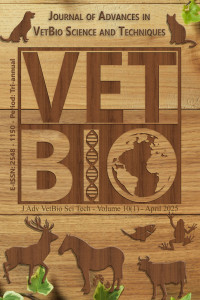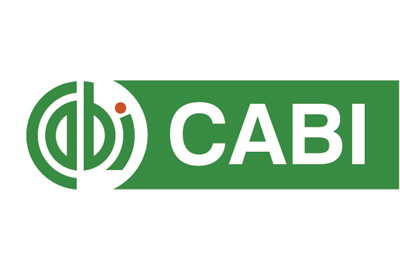Factors affecting beef demand in Türkiye for 2010-2021 and the effects of restrictions imposed during the Coronavirus disease (COVID-19) period
Abstract
In this study, the beef price, prices of substitute goods (lamb and chicken meat prices), change in national income and effects of COVID-19 on beef demand for the years 2010-2021 is examined using the ARDL Bounds Test Approach. The study finds that in the long run, an 1% increase in income leads to an approximately, on average, 0.54% increase in demand for beef whereas an 1% increase in beef prices results in, on average, an approximately 0.25% decrease in beef demand. Moreover it is determined that, in the long run, an increase of 1% in the price of lamb meat causes, on average, a 0.37% increase in beef demand, and an 1% increase in chicken meat prices results in on average, a 0.11% decrease in beef demand. This study also uses a dummy variable to account for COVID 19 pandemic effect on the demand of beef. According to the findings for this variable, the pandemic, reduces meat demand, on average, 11% with compared to non-pandemic period. As a result, the demand for beef is found to be affected by the income status of the consumer and the prices of the product itself and its substitutes.
References
- Akter, S. (2020). The impact of COVID-19 related ‘stay-at-home’restrictions on food prices in Europe: findings from a preliminary analysis. Food Security, 12(4), 719-725. https://doi.org/10.1007/s12571-020-01082-3
- Aydin, E., & Demir, P. A. (2022). The effect of the pandemic on the consumption of animal products: the case of Kafkas university of Turkey. Online Journal of Animal and Feed Research, 12(1), 37-45. https://doi.org/10.51227/ojafr.2022.6
- BLS (Bureau of Labor Statistics) (2022). Average Retail Food and Energy Prices. March 2022. https://www.bls.gov/regions/mid-atlantic/data/averageretailfoodandenergyprices_usandwest_table.htm
- Bracale, R., & Vaccaro, C. M. (2020). Changes in food choice following restrictive measures due to Covid-19. Nutrition, Metabolism and Cardiovascular Diseases, 30(9), 1423-1426. https://doi.org/10.1016/j.numecd.2020.05.027
- BSG (Blavatnik School of Government) (2022). COVID-19 government response tracker. March 2022. https://www.bsg.ox.ac.uk/research/covid-19-government-response-tracker.
- Coluccia, B., Agnusdei, G. P., Miglietta, P. P., & De Leo, F. (2021). Effects of COVID-19 on the Italian agri-food supply and value chains. Food Control, 123, 107839. https://doi.org/10.1016/j.foodcont.2020.107839
- EViews Corporation (2023). EViews-10 package program, USA: EViews Corp.
- GCDL(Global-Change-Data-Lab) (2022). Our world in data. September 2022. https://ourworldindata.org/ 10, 2023
- Güney, O. I., & Sangün, L. (2021). How COVID-19 affects individuals' food consumption behaviour: a consumer survey on attitudes and habits in Turkey. British Food Journal, 123(7), 2307-2320. https://doi.org/10.1108/BFJ-10-2020-0949
- Hatırlı, S. A., Öztürk, E., & Aktaş, A. R. (2008). Kırmızı, tavuk ve beyaz et talebinin tam talep sistemi yaklaşımıyla analizi. Süleyman Demirel Üniversitesi Sosyal Bilimler Enstitüsü Dergisi, 6(1), 211-222.
- Kerr, W. A. (2021). Agriculture after a year with COVID‐19: Any long‐term implications for international trade policy?. Canadian Journal of Agricultural Economics/Revue Canadienne D'agroeconomie, 69(2), 261-267. https://doi.org/10.1111/cjag.12274
- Laguna, L., Fiszman, S., Puerta, P., Chaya, C., & Tárrega, A. (2020). The impact of COVID-19 lockdown on food priorities. Results from a preliminary study using social media and an online survey with Spanish consumers. Food Quality and Preference, 86, 104028. https://doi.org/10.1016/j.foodqual.2020.104028
- LMIC (Livestock Marketing Information Center) (2022). Prices-and-production datas. https://lmic.info/spreadsheet/prices-and-production
- Long, N. N., & Khoi, B. H. (2020). An empirical study about the intention to hoard food during COVID-19 pandemic. Eurasia Journal of Mathematics, Science and Technology Education, 16(7), 1-12. https://doi.org/10.29333/ejmste/8207
- Mallory, M. L. (2021). Impact of COVID‐19 on medium‐term export prospects for soybeans, corn, beef, pork, and poultry. Applied Economic Perspectives and Policy, 43(1), 292-303. https://doi.org/10.1002/aepp.13113
- Martin-Neuninger, R., & Ruby, M. B. (2020). What does food retail research tell us about the implications of coronavirus (COVID-19) for grocery purchasing habits? Frontiers in Psychology, 1(11), 1-10. https://doi: 10.3389/fpsyg.2020.01448
- Narayan, P. K., & Smyth, R. (2006). What determines migration flows from low‐income to high‐income countries? An empirical investigation of Fiji–Us migration 1972–2001. Contemporary Economic Policy, 24(2), 332-342. https://doi.org/10.1093/cep/byj019
- Nordhagen, S., Igbeka, U., Rowlands, H., Shine, R. S., Heneghan, E., & Tench, J. (2021). COVID-19 and small enterprises in the food supply chain: Early impacts and implications for longer-term food system resilience in low-and middle-income countries. World Development, 141(1), 1-9. https://doi.org/10.1016/j.worlddev.2021.105405
- Pesaran, H.M., & Shin, Y. (1999). Autoregressive distributed lag modelling approach to cointegration analysis. In Strom, S. (Ed.) Econometrics and Economic Theory in the 20th Century. Century (pp 146-155). Akademic Press Association. https://doi.org/10.1017/CCOL521633230.011UK:
- Pesaran, H.M., Shin, Y., & Smith, R.J. (2001). Bounds testing approaches to the analysis of level relationships. Journal of Applied Econometrics, 16(2), 289-326. https://doi.org/10.1002/jae.616
- Rude, J. (2021). COVID‐19 and the Canadian cattle/beef sector: A second look. Canadian Journal of Agricultural Economics/Revue Canadienne D'agroeconomie, 69(2), 233-241. https://doi.org/10.1111/cjag.12277
- Saygın, Ö., & Demirbaş, N. (2018). Red meat consumption in Turkey: Problems and suggestions. Selcuk Journal of Agriculture and Food Sciences, 32(3), 567-574. https://doi: 10.15316/sjafs.2018.138
- Snuggs, S., & McGregor, S. (2021). Food & meal decision making in lockdown: How and who has Covid-19 affected? Food Quality and Preference, 89, 104145. https://doi.org/10.1016/j.foodqual.2020.104145
- STATCAN (Statistics Canada) (2022). Monthly average retail prices for food and other selected products. https://www150.statcan.gc.ca/t1/tbl1/en/tv.action?pid=1810024501
- Toda, H. (1991). Vector autoregression and causality. USA: Connecticut University Publishing.
- Tuncel, S (2023). Comparison of different levels of restrictions ımposed ın turkey during the covid-19 pandemic with the data on the demand for meat at the outlets of the Meat and Milk Board. Сukurova Agriculture And Veterınary Congress, Turkiye, 111-119. https://www.ziraatkongresi.org/_files/ugd/614b1f_b765b569900843648371b1d707f2d4aa.pdf
- TSI (Turkish Statistical Institute) (2022a). Annual meat and milk production statistics. https://data.tuik.gov.tr/Bulten/Index?p=Kirmizi-Et-Uretim-Istatistikleri-2022-49696#:~:text=Bu%20kapsamda%20bir%20%C3%B6nceki%20y%C4%B1la,13%20bin%20586%20ton%20oldu.
- TSI (Turkish Statistical Institute) (2022b). Quarterly meat production statistics. https://data.tuik.gov.tr/Bulten/Index?p=Red-Meat-Production-Statistics-2020-2021-4567
- TSI (Turkish Statistical Institute) (2022c). Quarterly adjustment statistics. https://biruni.tuik.gov.tr/medas/?kn=79&locale=tr
- TSI (Turkish Statistical Institute) (2022d). Meat import statistics. https://iz.tuik.gov.tr/#/showcase/SC-2851FY777F34D2R/db-dfr20j85b986782?token=8d79727fff862a891ce574d27220bfebbf66fecd
- TSI (Turkish Statistical Institute) (2022e). Prices of animal products. https://data.tuik.gov.tr/Bulten/Index?p=Canli-Hayvan-ve-Hayvansal-Urun-Fiyatlari-ve-Uretim-Degeri-2021-45507
- TSI (Turkish Statistical Institute) (2022f). National income Statistics. https://data.tuik.gov.tr/Bulten/Index?p=Gelir-Dagilimi-Istatistikleri-2022-49745#:~:text=T%C3%BCrkiye'de%20y%C4%B1ll%C4%B1k%20ortalama%20hanehalk%C4%B1,98%20bin%20416%20TL%20oldu.andtext=T%C3%BCrkiye'de%20y%C4%B1ll%C4%B1k%20ortalama%20e%C5%9Fde%C4%9Fer,bin%20642%20TL'ye%20y%C3%BCkseldi
- Statistical Institute) (2022g). Tüketici fiyat endeksi istatistikleri. https://data.tuik.gov.tr/Bulten/Index?p=Tuketici-Fiyat-Endeksi-Haziran-2023-49658#:~:text=T%C3%9C%C4%B0K%20Kurumsal&text=T%C3%9CFE'deki%20(2003%3D100,%59%2C95%20olarak%20ger%C3%A7ekle%C5%9Fti
- USDA (United States Department Of Agriculture) (2022). Monthly commercial slaughter of commercial beef, pork, and poultry. https://www.ers.usda.gov/webdocs/outlooks/100071/ldp-m-318.pdf
- Weersink, A., Massow, MV., Bannon, N., Ifft, J., Maples, J., McEwan, K., Melissa, GS., McKendre, E., Nicholson, C., Novakovic, A., Rangarajan, A., Richards, T., Rickard, B., Rude, J., Schipanski, M., Schnitkey G., Schulz, L., Schuurman, D., Schwartzkopf-Genswein K., Stephenson, M,, Thompson, J & Wood, K. (2021). COVID-19 and the agri-food system in the United States and Canada. Agricultural Systems, 188, 103039. https://doi.org/10.1016/j.agsy.2020.103039
Abstract
References
- Akter, S. (2020). The impact of COVID-19 related ‘stay-at-home’restrictions on food prices in Europe: findings from a preliminary analysis. Food Security, 12(4), 719-725. https://doi.org/10.1007/s12571-020-01082-3
- Aydin, E., & Demir, P. A. (2022). The effect of the pandemic on the consumption of animal products: the case of Kafkas university of Turkey. Online Journal of Animal and Feed Research, 12(1), 37-45. https://doi.org/10.51227/ojafr.2022.6
- BLS (Bureau of Labor Statistics) (2022). Average Retail Food and Energy Prices. March 2022. https://www.bls.gov/regions/mid-atlantic/data/averageretailfoodandenergyprices_usandwest_table.htm
- Bracale, R., & Vaccaro, C. M. (2020). Changes in food choice following restrictive measures due to Covid-19. Nutrition, Metabolism and Cardiovascular Diseases, 30(9), 1423-1426. https://doi.org/10.1016/j.numecd.2020.05.027
- BSG (Blavatnik School of Government) (2022). COVID-19 government response tracker. March 2022. https://www.bsg.ox.ac.uk/research/covid-19-government-response-tracker.
- Coluccia, B., Agnusdei, G. P., Miglietta, P. P., & De Leo, F. (2021). Effects of COVID-19 on the Italian agri-food supply and value chains. Food Control, 123, 107839. https://doi.org/10.1016/j.foodcont.2020.107839
- EViews Corporation (2023). EViews-10 package program, USA: EViews Corp.
- GCDL(Global-Change-Data-Lab) (2022). Our world in data. September 2022. https://ourworldindata.org/ 10, 2023
- Güney, O. I., & Sangün, L. (2021). How COVID-19 affects individuals' food consumption behaviour: a consumer survey on attitudes and habits in Turkey. British Food Journal, 123(7), 2307-2320. https://doi.org/10.1108/BFJ-10-2020-0949
- Hatırlı, S. A., Öztürk, E., & Aktaş, A. R. (2008). Kırmızı, tavuk ve beyaz et talebinin tam talep sistemi yaklaşımıyla analizi. Süleyman Demirel Üniversitesi Sosyal Bilimler Enstitüsü Dergisi, 6(1), 211-222.
- Kerr, W. A. (2021). Agriculture after a year with COVID‐19: Any long‐term implications for international trade policy?. Canadian Journal of Agricultural Economics/Revue Canadienne D'agroeconomie, 69(2), 261-267. https://doi.org/10.1111/cjag.12274
- Laguna, L., Fiszman, S., Puerta, P., Chaya, C., & Tárrega, A. (2020). The impact of COVID-19 lockdown on food priorities. Results from a preliminary study using social media and an online survey with Spanish consumers. Food Quality and Preference, 86, 104028. https://doi.org/10.1016/j.foodqual.2020.104028
- LMIC (Livestock Marketing Information Center) (2022). Prices-and-production datas. https://lmic.info/spreadsheet/prices-and-production
- Long, N. N., & Khoi, B. H. (2020). An empirical study about the intention to hoard food during COVID-19 pandemic. Eurasia Journal of Mathematics, Science and Technology Education, 16(7), 1-12. https://doi.org/10.29333/ejmste/8207
- Mallory, M. L. (2021). Impact of COVID‐19 on medium‐term export prospects for soybeans, corn, beef, pork, and poultry. Applied Economic Perspectives and Policy, 43(1), 292-303. https://doi.org/10.1002/aepp.13113
- Martin-Neuninger, R., & Ruby, M. B. (2020). What does food retail research tell us about the implications of coronavirus (COVID-19) for grocery purchasing habits? Frontiers in Psychology, 1(11), 1-10. https://doi: 10.3389/fpsyg.2020.01448
- Narayan, P. K., & Smyth, R. (2006). What determines migration flows from low‐income to high‐income countries? An empirical investigation of Fiji–Us migration 1972–2001. Contemporary Economic Policy, 24(2), 332-342. https://doi.org/10.1093/cep/byj019
- Nordhagen, S., Igbeka, U., Rowlands, H., Shine, R. S., Heneghan, E., & Tench, J. (2021). COVID-19 and small enterprises in the food supply chain: Early impacts and implications for longer-term food system resilience in low-and middle-income countries. World Development, 141(1), 1-9. https://doi.org/10.1016/j.worlddev.2021.105405
- Pesaran, H.M., & Shin, Y. (1999). Autoregressive distributed lag modelling approach to cointegration analysis. In Strom, S. (Ed.) Econometrics and Economic Theory in the 20th Century. Century (pp 146-155). Akademic Press Association. https://doi.org/10.1017/CCOL521633230.011UK:
- Pesaran, H.M., Shin, Y., & Smith, R.J. (2001). Bounds testing approaches to the analysis of level relationships. Journal of Applied Econometrics, 16(2), 289-326. https://doi.org/10.1002/jae.616
- Rude, J. (2021). COVID‐19 and the Canadian cattle/beef sector: A second look. Canadian Journal of Agricultural Economics/Revue Canadienne D'agroeconomie, 69(2), 233-241. https://doi.org/10.1111/cjag.12277
- Saygın, Ö., & Demirbaş, N. (2018). Red meat consumption in Turkey: Problems and suggestions. Selcuk Journal of Agriculture and Food Sciences, 32(3), 567-574. https://doi: 10.15316/sjafs.2018.138
- Snuggs, S., & McGregor, S. (2021). Food & meal decision making in lockdown: How and who has Covid-19 affected? Food Quality and Preference, 89, 104145. https://doi.org/10.1016/j.foodqual.2020.104145
- STATCAN (Statistics Canada) (2022). Monthly average retail prices for food and other selected products. https://www150.statcan.gc.ca/t1/tbl1/en/tv.action?pid=1810024501
- Toda, H. (1991). Vector autoregression and causality. USA: Connecticut University Publishing.
- Tuncel, S (2023). Comparison of different levels of restrictions ımposed ın turkey during the covid-19 pandemic with the data on the demand for meat at the outlets of the Meat and Milk Board. Сukurova Agriculture And Veterınary Congress, Turkiye, 111-119. https://www.ziraatkongresi.org/_files/ugd/614b1f_b765b569900843648371b1d707f2d4aa.pdf
- TSI (Turkish Statistical Institute) (2022a). Annual meat and milk production statistics. https://data.tuik.gov.tr/Bulten/Index?p=Kirmizi-Et-Uretim-Istatistikleri-2022-49696#:~:text=Bu%20kapsamda%20bir%20%C3%B6nceki%20y%C4%B1la,13%20bin%20586%20ton%20oldu.
- TSI (Turkish Statistical Institute) (2022b). Quarterly meat production statistics. https://data.tuik.gov.tr/Bulten/Index?p=Red-Meat-Production-Statistics-2020-2021-4567
- TSI (Turkish Statistical Institute) (2022c). Quarterly adjustment statistics. https://biruni.tuik.gov.tr/medas/?kn=79&locale=tr
- TSI (Turkish Statistical Institute) (2022d). Meat import statistics. https://iz.tuik.gov.tr/#/showcase/SC-2851FY777F34D2R/db-dfr20j85b986782?token=8d79727fff862a891ce574d27220bfebbf66fecd
- TSI (Turkish Statistical Institute) (2022e). Prices of animal products. https://data.tuik.gov.tr/Bulten/Index?p=Canli-Hayvan-ve-Hayvansal-Urun-Fiyatlari-ve-Uretim-Degeri-2021-45507
- TSI (Turkish Statistical Institute) (2022f). National income Statistics. https://data.tuik.gov.tr/Bulten/Index?p=Gelir-Dagilimi-Istatistikleri-2022-49745#:~:text=T%C3%BCrkiye'de%20y%C4%B1ll%C4%B1k%20ortalama%20hanehalk%C4%B1,98%20bin%20416%20TL%20oldu.andtext=T%C3%BCrkiye'de%20y%C4%B1ll%C4%B1k%20ortalama%20e%C5%9Fde%C4%9Fer,bin%20642%20TL'ye%20y%C3%BCkseldi
- Statistical Institute) (2022g). Tüketici fiyat endeksi istatistikleri. https://data.tuik.gov.tr/Bulten/Index?p=Tuketici-Fiyat-Endeksi-Haziran-2023-49658#:~:text=T%C3%9C%C4%B0K%20Kurumsal&text=T%C3%9CFE'deki%20(2003%3D100,%59%2C95%20olarak%20ger%C3%A7ekle%C5%9Fti
- USDA (United States Department Of Agriculture) (2022). Monthly commercial slaughter of commercial beef, pork, and poultry. https://www.ers.usda.gov/webdocs/outlooks/100071/ldp-m-318.pdf
- Weersink, A., Massow, MV., Bannon, N., Ifft, J., Maples, J., McEwan, K., Melissa, GS., McKendre, E., Nicholson, C., Novakovic, A., Rangarajan, A., Richards, T., Rickard, B., Rude, J., Schipanski, M., Schnitkey G., Schulz, L., Schuurman, D., Schwartzkopf-Genswein K., Stephenson, M,, Thompson, J & Wood, K. (2021). COVID-19 and the agri-food system in the United States and Canada. Agricultural Systems, 188, 103039. https://doi.org/10.1016/j.agsy.2020.103039
Details
| Primary Language | English |
|---|---|
| Subjects | Animal Health Economics and Management |
| Journal Section | Research Articles |
| Authors | |
| Publication Date | April 30, 2025 |
| Submission Date | September 16, 2024 |
| Acceptance Date | February 18, 2025 |
| Published in Issue | Year 2025 Volume: 10 Issue: 1 |




